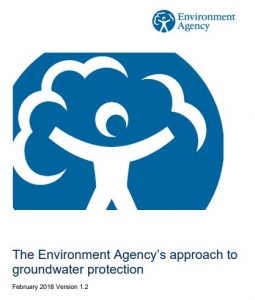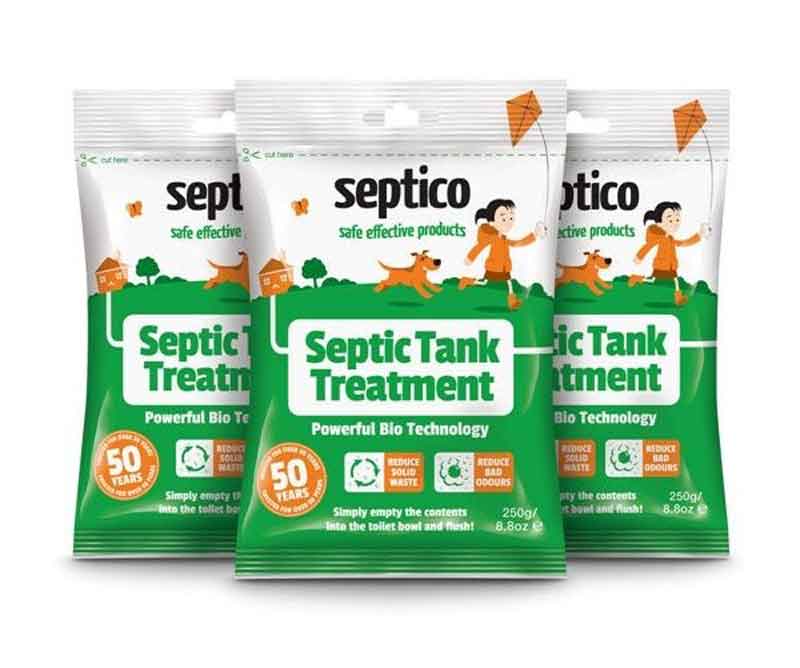Dreaming of a life in the wilderness? Whether you’re self-building on a rural plot or starting an eco-friendly campsite in the middle of nowhere, there’s nothing like sorting out your septic system to kill the romance of your new off-grid lifestyle.
But while it may not be as glamorous as choosing your wood stove or solar panels, getting off-mains drainage installed is essential if you’re among the five per cent of UK homes too remote to connect to the main sewer system. From cesspools to septic tanks, there are different options available, but sewage treatment plants are fast becoming the preferred option for off-system homes, farms and businesses.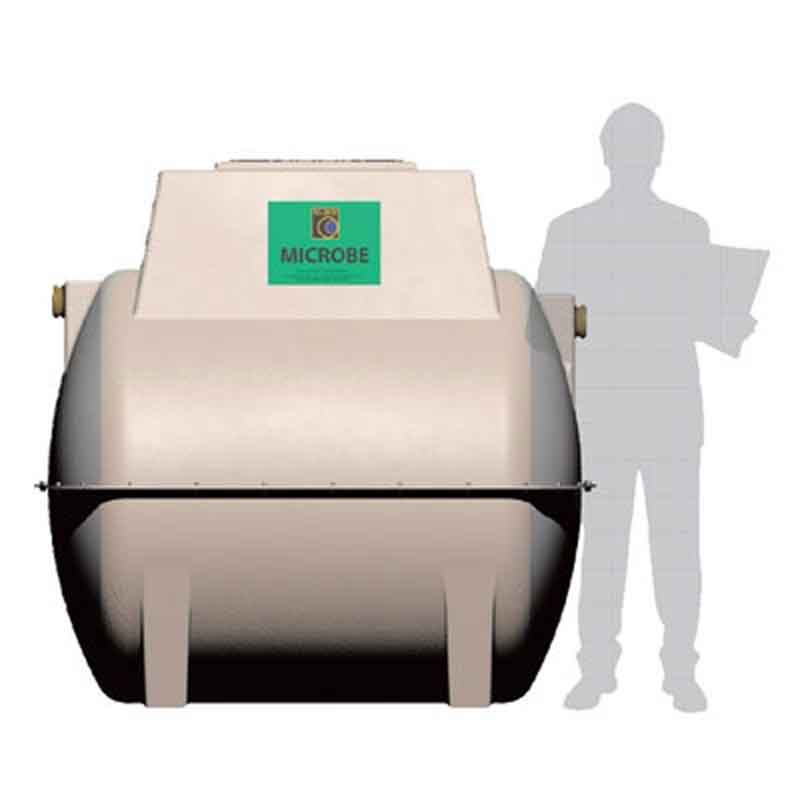
Affordable, clean and eco-friendly, sewage treatment plants may also be your only option if you plan to discharge your wastewater into a stream or ditch. According to new environmental laws that came into effect in 2015, even those with septic tanks already installed will need to upgrade their systems by 2020 if they use a watercourse to dispose of their liquid effluent.
But how do sewage treatment plants compare to other septic systems, like cesspools or septic tanks? What size sewage treatment plant do you need? And what do you need to consider before you go ahead and buy one? Our guide to sewage treatment plants has all the answers.
Table of contents
- What’s the difference between a cesspool, septic tank and a sewage treatment plant?
- Septic tanks vs sewage treatment plants: Which one is best?
- How do sewage treatment plants work?
- Discharging wastewater and emptying sewage treatment plants
- What types of sewage treatment plant can you buy?
- What size sewage treatment plant do I need?
- What are the rules and regulations of sewage treatment plants?
- Who can install a sewage treatment plant and how long do they take to work?
- What do I need to consider about where to install a sewage treatment plant?
- Other advice, tips and guidance on purchasing a sewage treatment plant
What’s the difference between a cesspool, a septic tank and a sewage treatment plant?
Building regulations state that if you can’t connect to a public sewer, you’ll need either a cesspool, septic tank or sewage treatment plant instead. But what do these three terms mean? Understanding the basic differences between the options available is the first step to getting just what you need.
Cesspools
A cesspool (otherwise known as a cesspit) is essentially a sewage holding tank with no outlet and no facilities to treat the waste that goes in. Waste simply flows into the cesspool to be stored and then, in six to eight weeks when the tank is full, a lorry will tanker it away for disposal. The tank can be vented to allow gas build-up to escape, but a septic tank is otherwise completely sealed.
Most suitable for: Sensitive sites and places that are close to drinking water supplies as all waste will be contained before being safely taken away. A cesspool can be an option if the ground is unsuitable for waste to soak away.
Advantages: Cesspools are generally the cheapest option, with both a low installation and maintenance cost.
Disadvantages: The sewage inside a cesspool won’t be treated. Cesspools require regular emptying which can cost up to £300 each time, and this may need to be done as many as eight times each year. Not only that but cesspools are banned in Scotland and thought of as a last resort in the rest of the UK.
Maintenance: Using cesspool treatments can help keep the bacteria that break down the waste healthy. This means the solid matter in the tank will remain low, so you won’t need to empty it as frequently.
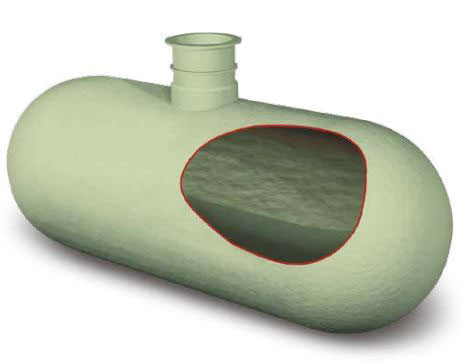
Septic Tanks
Unlike a cesspool, septic tanks are multi-chambered and can treat and discharge the liquid part of the sewage. Waste enters the first tank where gravity separates the liquids from the solids. The liquid effluent flows out of the tank and discharges to land, where it is cleaned as it percolates through the soil. The solids sink to the bottom, where some of the ‘sludge’ is broken down by natural bacteria, but the rest will need to be taken away by lorry, as with cesspools.
Most suitable for: A single house or a small development. You’ll also need a drainage field or mound that is porous enough to allow the liquid effluent to discharge, something that’s determined by a ground percolation test.
Advantages: Relatively low installation and running costs as they only require emptying (otherwise known as ‘desludging’) once or twice a year.
Disadvantages: Only suitable if your ground is porous enough to allow the waste to percolate through because septic tanks can no longer be discharged into a watercourse under new laws.
Maintenance: Breaking down the waste relies on natural bacteria, which can be killed off by bleach or harsh chemicals in today’s wastewater. Septic tank treatments can help keep the bacteria healthy – and your septic tank’s running costs low.
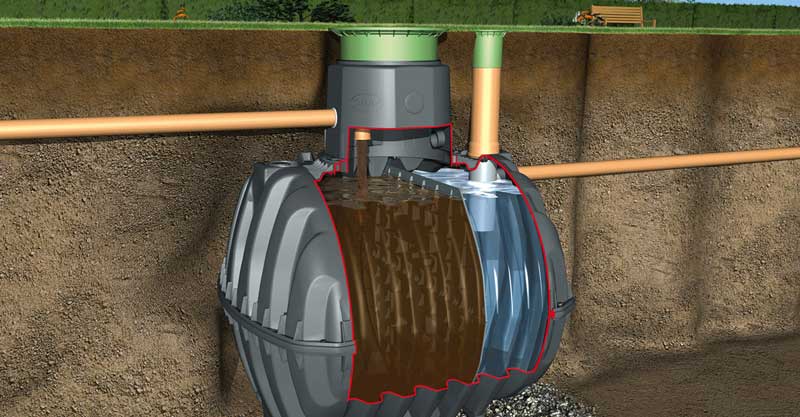
Sewage Treatment Plants
Having your own sewage treatment plant may sound grand, but there are small-scale, affordable domestic units as well as large-scale, commercial units. While several types are available, they all work in the same way (which we’ll explain in more detail below) – by creating an environment that allows the helpful waste-degrading bacteria to flourish.
Most suitable for: Everything from single domestic dwellings right up to large developments. It is the only option if you want to discharge your treated waste into a ditch or stream.
Advantages: Affordable, clean and sewage treated to a higher standard so that it has a minimal negative impact on the environment.
Disadvantages: Requires an electricity supply and regular maintenance and, while the volume of solid matter is greatly reduced, it’ll still need pumping into a lorry for disposal.
Maintenance: With more moving parts than septic tanks or cesspools, sewage treatment is more prone to wear and tear, so will require regular maintenance.
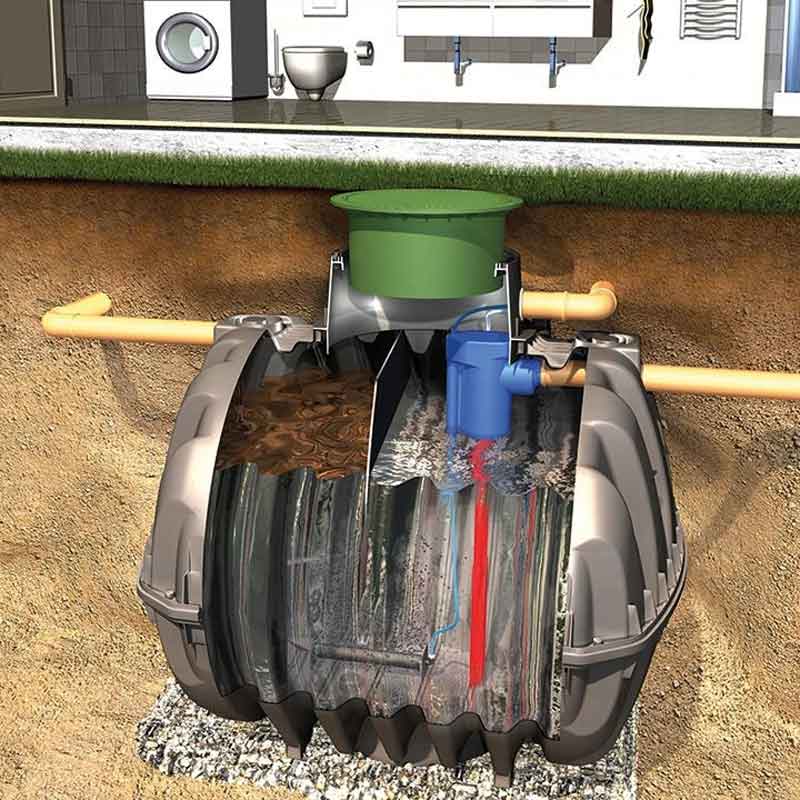
Septic tanks vs sewage treatment plants: Which one is best?
Sewage treatment plants are fast becoming the preferred option for those not on the main sewage system, but why? The following may help if you’re torn between getting a septic tank and a sewage treatment plant.
Environmental credentials
The sewage treatment plant wins hands down when it comes to being environmentally friendly. Septic tanks make a highly polluting effluent high in ammonia which, under new laws, cannot be discharged into a watercourse. Instead, it can only be discharged to a soakaway or drainage mound for further treatment of the pollutants by the natural aerobic soil bacteria.
A sewage treatment plant, however, produces clean, non-polluting effluent. In fact, as it leaves the final waste chamber to be discharged, the effluent can be as much as 95% clean, posing no threat to the environment.
Electricity
No power supply? No problem if you’ve got a septic tank because these don’t require electricity to run. Below is an image of how a septic tank works.
Most sewage treatment plants do require a power source because they work by pumping in compressed air or by rotating discs. However, you don’t normally need a very large supply – sometimes just the amount of power it takes to run a 60 watt light bulb.
But where will you get this power if you’re off-grid? It normally comes from the main circuit board in your house or a generator. Just be aware that if several households are sharing a sewage treatment plant, you’ll need a shared supply with a separate meter or only one of you will be footing the bill.
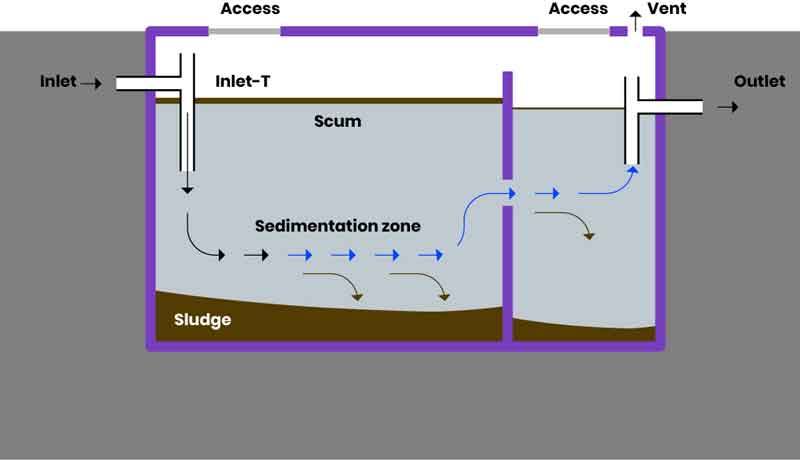
Maintenance
Septic tanks have previously been a great option for those not on the main sewer system because they’re incredibly low maintenance – they only need to be emptied once or twice a year and can last for over 20 years.
Sewage treatment plants may require a little more upkeep as they have more moving parts, yet they produce such little sludge that they may need emptying even less frequently (although it’s recommended that you do de-sludge once a year to make sure no solids can build up and damage the treatment chamber).
Cost
Sewage treatment plants may be more expensive than septic tanks but this is soon recovered in lower running costs.
Legal Compliance
Want to discharge your treated wastewater to a river or stream? By law, a sewage treatment plant is your only option. The UK’s Environment Agency introduced new binding rules on sewage treatment on 1 January 2015 which state, “You must use a small sewage treatment plant to treat the sewage if you’re discharging to a surface water such as a river or stream.”
And that’s not all. Even if you already have a septic tank already installed, if it discharges to water you’ll either need to replace it with a sewage treatment plant or discharge to ground instead, by 2020.
How do sewage treatment plants work?
The job of a sewage treatment plant is very simple. It cleans all the wastewater a building produces (think showers, baths, toilets, dishwashers and sinks) so that it can then be discharged safely into a river or stream. With all the nasties removed, the water it produces should pose no harm to plants, wildlife or fish.
So how do they do this? All sewage treatment plants work in similar ways. First, the wastewater flows into the primary chamber, where gravity separates any solids from the liquid. The solids sink to the bottom to form what’s known as a sludge which will be tankered away at a later date.
The remaining liquid flows into the second chamber for treatment. In this biological zone, compressed air is pumped in, and this added oxygen encourages the naturally occurring aerobic bacteria to flourish. Some sewage treatment plants also have rotating discs which give the bacteria a larger surface area to grow on.
At this point, the treated effluent goes into the final part of the tank – a calm area that allows the bacteria to settle at the bottom (for removal back into the first tank) while the clean liquid can flow out either to a watercourse (subject to Environment Agency consent) or to a ground soakaway field or drainage mound.
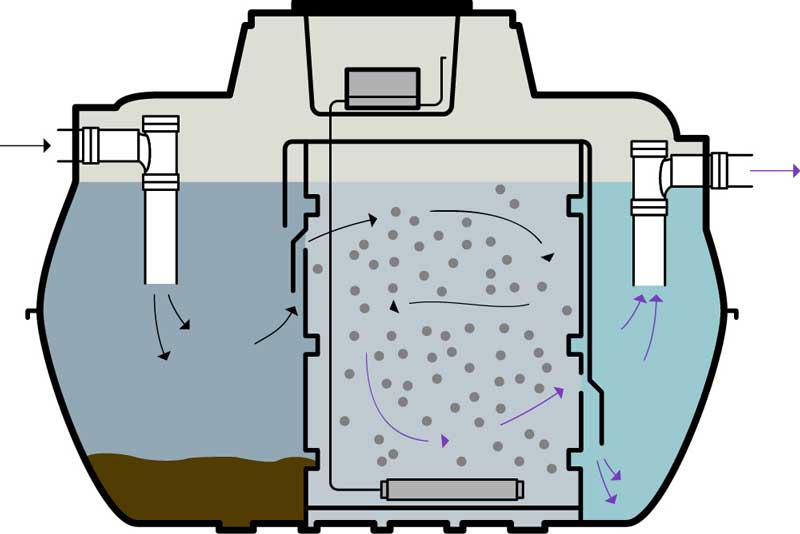
Do sewage treatment plants still need emptying?
Yes, just as with a septic tank, the sludge still needs to be emptied by the tanker because the job of the sewage treatment plant is really just to clean the water. Most manufacturers will recommend you empty them once a year to keep sludge from building up – and remember that some low-budget options may need emptying more frequently than this.
Where can I discharge the wastewater?
Your wastewater can either be discharged to a watercourse like a river or a stream, or to a soakaway treatment system such as a drainage mound. If you’re planning on discharging to water, your effluent needs to abide by certain rules laid down by the Environment Agency. If it’s not clean enough or there’s lots of it, you’ll need to apply for a Consent to Discharge (explained below).
What types of sewage treatment plants can you buy?
The main manufacturers of sewage treatment plants include Marsh Industries, GRAF, Kingspan and Tricel.
Market leaders Marsh Industries are best known for their innovative Ensign range, in which all products are unobtrusive, easy to install and approved for discharge into a watercourse.
Best known for its high-quality plastic products, GRAF has been making its own sewage treatment plant products for the last few years out of incredibly light but strong plastic. They’re best known for their simple-to-use One2Clean range which produces incredibly little sewage sludge, meaning less emptying and lower maintenance costs.
Kingspan is known globally for its domestic and commercial Klargester range of sewage treatment plants, but its flagship model has to be the Klargester Biodisc. Its unique design uses a rotating biological contractor – essentially moving discs on which more bacteria can grow and flourish.
Sewage treatment plants from Tricel are made out of reinforced glass for one of the longest life spans around. Plus you won’t need a concrete backfill with Tricel products, something that can save time and money when it comes to installation.
Finally, WPL Diamond whos range of WPL Diamond sewage treatment plants are simple, compact, odourless, discreet and are entirely hidden underground. Perfect for domestic and commercial properties, their WPL Diamond DMS model is especially popular for its small and compact design. It also requires no use of chemicals, ensuring the treated effluent can be discharged into a soakaway or watercourse in safely and in an environmentally-friendly way.

What size sewage treatment plant do I need?
It all depends on the size of your property and the number of people that are going to be staying there. But don’t go too small! You must size the treatment plant for its potential occupancy not how many people are there at the moment – it can save you money, in the long run, to over-estimate rather than underestimate when you’re at the planning stage! Below shows a commercial Marsh sewage treatment plant that suits a 70-person residence.
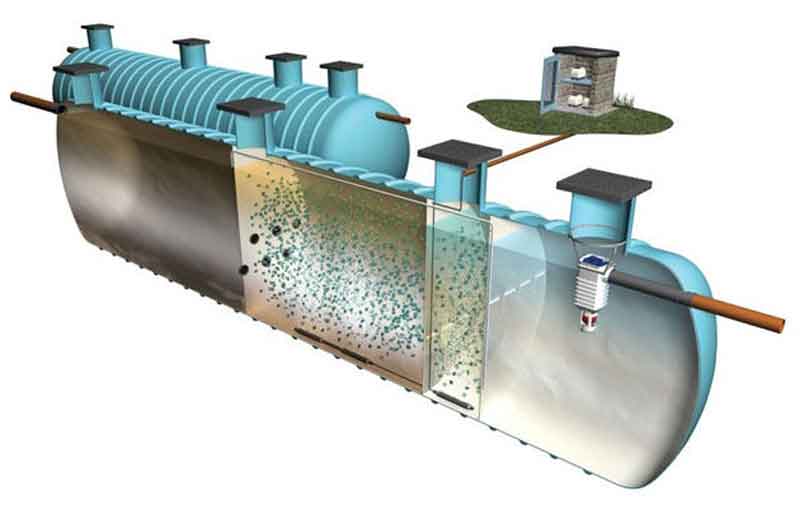
British Water Flows and Loads state that for a three-bedroom property, you’ll need to size your treatment plant at five people.
When it comes to sizing a sewage treatment plant for commercial use, you’ll need to know what the PE number is. Standing for ‘Population Equivalent’, this relates to the number of workers using the building. For example, an office with 30 workers is thought to be equivalent to 10 domestic residents, so its PE number is 10. Read our full guide on sewage treatment plant sizing here.
What are the rules and regulations around sewage treatment plants?
There are a number of legal requirements you’ll have to adhere to when it comes to sewage treatment plants.
Legal Compliance
For starters, you’ll need to make sure your sewage treatment plant is legally compliant – particularly if you’ve moved into a property with an old model. All sewage treatment plants need to be EN 12566-3 2005 certified – without that, the unit will not be legal in the UK.
Consent to Discharge
If you want the liquid effluent produced by your sewage treatment plant to run off into a watercourse, such as a stream or ditch, you may have heard that you need to apply for ‘consent to discharge’ – which is basically a licence that says your wastewater is now clean enough not to damage local wildlife.
But will you need to apply for consent to discharge, or not? Well, the government’s binding rules that come into effect in 2020 state that you only need to apply for one if you are:
- Not using a package treatment plant
- Discharging over 5,000 litres per day
- Discharging to a chalk river
- Discharging in a site of scientific special interest
So if you’re adhering to these criteria, you won’t have to make the application for a permit and can avoid the lengthy forms and cost. If you can’t adhere to these general binding rules for whatever reason, you’ll need to contact your local Environment Agency office, complete a ‘Consent to Discharge Application Form’ and pay an application fee, dependent upon the amount of sewage you propose to discharge.
Planning Permission
Whether your sewage treatment plant needs planning permission is at the discretion of your local authority. If it forms part of a new build your sewage treatment plant will be part of the main approval.
Who can install a sewage treatment plant?
Even if you’re pretty handy, this is one job that needs to be left to the experts. There are a lot of things to consider such as the type of terrain and soil you have, the length of pipework you’ll need and how deep to excavate the hole. Plus, digging large holes in the ground comes with its own considerations – and dangers! You’ll need to employ the experts – a groundwork contractor for installing the tank and an electrician to connect it up to the power supply.
How long does it take a sewage treatment plant to work?
It should take about six weeks from when you start up the system. You could speed this time up by seeding the unit with the sludge from an operational aerobic sewage treatment system, or for septic tanks and cesspools, you can add treatments.
What can I put into my sewage treatment plant?
While you’ll want to steer clear of putting anything such as wet wipes or sanitary products into the sewage system, all normal household cleaning products can be used, in sensible quantities. Watch out for antibacterial cleansers though. Your sewage treatment plant relies on those clever microorganisms so the last thing you should do is kill them off.
Another thing to avoid getting into your sewage treatment plant is rainwater, as this can flush out the helpful bacteria and flood the system.
You should also avoid food waste wherever possible, as this is harder for the system to break down.
What do I need to consider about where to install a sewage treatment plant?
Your groundwork contractor can help, but there are lots of things you’ll need to bear in mind before finding the perfect place to site your sewage treatment plant. Remember that building regulations insist that it should not be closer than seven metres from the foundations of your home and 10 metres from the watercourse. Other than that, here are some other things to bear in mind…
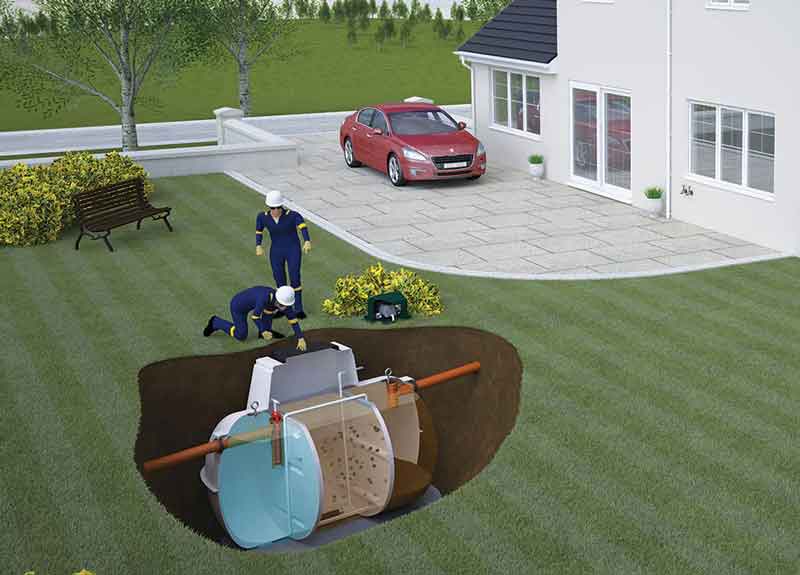
Can the lorry pull up close enough when it’s time to empty the tank?
Your sewage treatment plant will need emptying at some point, usually once a year. So you’ll want to site it less than 30 metres away from some hardstanding, or the lorry will find it hard to pull up close enough.
Can gravity help my sewage treatment plant to work?
Putting the sewage treatment plant downhill from your house means that gravity will help the wastewater along, without the need for extra pumps.
Will we be able to smell it?
When working properly, sewage treatment plants don’t really smell that much at all, but when they are being emptied you probably will be able to smell it. That may just be once a year, but even so, you’ll probably want to site it as far away from any inhabited buildings as possible.
Will the noise of the sewage treatment plant affect us?
Some treatment systems are louder than others, but all will emit some kind of buzzing or gurgling sound. If you’re a light sleeper, it may be best to keep it away from under your bedroom window.
What information do I need to know before I can order my sewage treatment plant?
You’ll need to know the following before you buy:
- The depth of your drainage pipes
- The depth of the outfall from the treatment plant
- Whether you’re using gravity or will require a pumped system
- The size of the system you need
How to maintain your sewage treatment plant
Most sewage treatment plants are serviced once a year and this really is important. For starters, regular maintenance means you’ll be within warranty if things go wrong, but also means your waste is polluting your property or local wildlife.
A service will check that each of the plant’s working parts is still running properly and that you have the right levels of microorganisms and they’ll also let you know when it needs to be desludged. You may have to replace the live bacteria if they’re no longer doing their job.
This sewage treatment plant buyer’s guide contains all the information you need to know, but if you want to speak to an expert give Drainage Superstore a call on 01752 692 221 to speak to an expert. Our team is trained by manufacturers and suppliers in sewage treatment plants, septic tanks and the relevant accessories.



